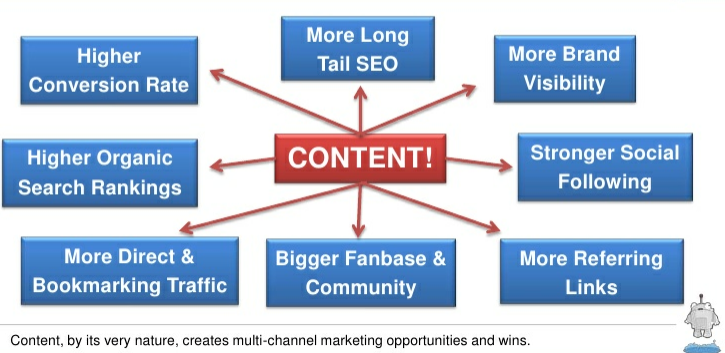
The Guide to Developing a Content Strategy for "Boring" Industries
The author's views are entirely their own (excluding the unlikely event of hypnosis) and may not always reflect the views of Moz.
There have been multiple articles that have discussed the value and opportunities that content marketing brings to SEO - from organically building external links and ranking for more long tail keywords, to establishing a community and building brand awareness. As the SEO industry slowly moves away from manual linkbuilding and adapts a more long-term and forward-thinking approach (whether it be forced as a result of recent aggressive Google algorithm updates or because as an industry, we're starting to seek a sustainable methodology to establish authority), the challenge is in figuring out how to set up a proper framework that would help our community develop a content strategy for all websites.

Image courtesy of SEOmoz
The goal of this post is to show the SEO community how to start thinking about how to develop a cohesive and integrated long-term content strategy (and not just one-off linkbait pieces). It won't be easy and definitely will not result in immediate returns, but if the goal is to build a sustainable and authoritative site in the long-term, the upfront costs can be justified. To show you the steps of how to create a content strategy, I've chosen what might be a seemingly "boring" industry (and an industry I knew very little about prior to writing this post), tires, to demonstrate how a content strategy is possible for all industries and all sites, and how a little research can go a long way.

Image courtesy of Distilled
Step 1: Asking the Right Questions (Learning About the Industry)
As an industry, we already have a very good idea of how people in general use the Internet. However, if I were to do a content strategy specifically tailored around the tire industry, I would want to understand how the core demographic for tires is utilizing the Internet.
For example, the type of questions we want to learn about tire shoppers could be:
- How do tire shoppers use the Internet?
- Where do they spend their time online?
- Who is considered an influencer in the tire industry?
We also want to understand what the industry landscape looks like.
- Who are your business competitors? Who are your online competitors?
-
What currently makes up your biggest market? What markets are out there that you might not have previously targeted? Examples include:
- Car aficionados
- Car manufacturers
- General consumers
- Automobile repair/service shops
And more about your specific tire company.
- What story do you have? What is your company background?
- Why should an individual looking to purchase a tire choose you? What is your unique value proposition?
As well as, what does your current customer base look like?
- Are they advocates and influencers for your brand?
- Are they one-time/casual shoppers or repeat customers?
- Are they price-focused or are they service-oriented?
All this information helps you as an SEO garner a much deeper understanding about the tire business, which will be fundamentally important in determining the type of content to produce.
Following the background research on the tire industry, it's also worth speaking directly to individuals who you know are very knowledgeable about the tire industry - their insight can ultimately help you develop different personas to target. Let's say hypothetically, you own a tire company and through this research realized that street racers was a target demographic you could develop content for. Through the research, you've learned that the majority of street racers are:
- Upper middle class
- Lives in suburbia
- Ages 16-25
- Male
You want to start locating and having conversations with people who fit this demographic or, at the very least, have access and knowledge about this demographic. This will provide you with the type of insight that will help you develop content street racers would be interested in or will provide you with the opportunity to interact and potentially, influence street racers.
Step 2: Compiling the Data (Analysis of the Industry)
The second element of the project requires conducting an in-depth competitive analysis on the competitors and seek answers to the following questions:
- What types of backlinks has the site received? What types of relationships have these sites built?
- Is there one specific competitor who is dominating the industry? If so, spend more effort and time taking a deeper analysis of the site, its content, and its community. (This is especially apparent in the tire industry).
- What types of content has the site produced that have performed well?
- Are there are any content holes based on a culmination from the market research you've already compiled about the industry and the personas that you want to target?
It's also worth ensuring that your own site's metrics and analytics tracking is properly set up, which can be used to measure growth, traffic, and conversions.
Tire Industry Example:
For instance, in the tire industry, it's clear that the dominant player in the industry is Tire Rack.

The site has received links from high-authority sites like Car and Driver, the Webby Awards, ABC News, and Popular Mechanics.
What has been Tire Rack's competitive advantage?
Many of these articles talk about Tire Rack's video driving tests. For example, their Winter/Snow vs. All-Season vs. Summer Tires video has generated over 440,000 views. Their YouTube channel has over 1,000+ subscribers and over 2 million views.
They also have a back story, an army veteran who opened up shop in 1979 and made customer service/educating consumers his number one priority. The family-owned business now has 3 generations working at the shop. On top of it all, their price points are competitive with all major tire retailers.
However, it appears that the site targets the general consumer, meaning there is opportunity for other tire sites to develop content around different target personas, such as speed racers or truckers to name a few.
Step 3: Defining the Target Audiences and Identifying Project Goals
Using all of the above research, determine how you would differentiate your site from your competitors.
- Is it based on your target personas?
- Is it based on the type of content you will produce?
- Is it based on your brand voice?

Image Courtesy of SEOmoz
At the same time, you also must consider the internal resources that you have access to - what type of content could you more easily create based on the resources you have available? The reality is that often times, dependencies are involved - whether it be departmental approval for different forms of content or budget constraints. These all need to be taken into consideration when compiling a long-term content strategy.
Finally, define your goals - is it to develop content for your target audience? The integration of different marketing teams to build value? Develop a deeper understanding of your target audience? Become an authority in a specific space? All of the above?
What is the vision for investing this much effort/budget/time?
Tire Industry Example:
Let's say I wanted to target the street racer demographic. Based on my understanding of the target demographic, street racers would likely be interested in:

Image courtesy of YouTube
- Racing videos - burnouts, drifting, traction tests
- Comparison charts on different racing tires
- Magazines - for tuners and racers
- Street racing forums
I've included links to the best examples I could find. Clearly videos are a huge hit and have an enormous audience, but there isn't a single channel dominating street racing videos. The street racing forum is relatively active and I honestly could not find good examples of comparison charts on different racing tires or even a single linkworthy site of street racing resources. Clearly, there is an opportunity for a company who might be interested in targeting the street racing demographic to become the online authority of street racing.
Step 4: Prospecting Influencers / Determining Shareability
Before investing the time and budget to create a piece of content, first properly outreach and make sure that there is an audience who is willing to share this piece of content. Ideally this would be to sites that have the same audience/personas that you are trying to target. Take a look at social media for potential engagement opportunities (please read and apply Wil Reynold's "Stalking for Links"), search industry news, and reading the content that your competitors are creating.
Tire Industry Example:
If I were targeting the street racer demographic, I'd be very involved on the street racer forum, as well as other car forums that are active. Though this is a long-term strategy, ultimately, building relationships with these individuals is worthwhile.

Image courtesy of Honda-Tech
I'd also build relationships with street racers who have a large following on Twitter for the very same reason.

Image Courtesy of Followerwonk
Through investing in these relationships, not only will you be able to build relationships with influencers, you'll also gain a big picture understanding of the common questions street racers ask and thus, have insider knowledge of the type of content that will prove to be successful in helping to build your own following.
Step 5: Creating the Content
Now that we've conducted the market research for our industry, identified target personas, determined the type of content we could create, and initiated relationships with potential prospects that would share our content, the next step is to create the actual content.
We have to:
- Brainstorm the type of content we want to create and the form we want the piece of content to be in (white paper, video, infographic, data visualization, images)
- Filter the ideas and select which content you want to develop first
- Conduct research on that piece of content
- Develop the piece of content
- Outreach the content once the piece is live
Step 6: Analyzing the Results
Once outreach has been conducted on the content piece, we want to take the time to properly evaluate the metrics and draw conclusions. Overtime, you can measure a variety of metrics like:
- Was there an increase in traffic?
- Was there an increase in conversions? If not, is it because the landing page needs some CRO? Or is it because the target demographic didn't respond as expected to the content?
- If the target demographic did respond, is there any way to repurpose the content in other forms? (Let's say if wrote a guide, can we use that same type of content and post it into a video or an infographic?)
Based on the results of the content piece, the next steps are to iterate, test, and repeat with the purpose of ultimately building a following and a brand.
Conclusion
The purpose of this post was to help you develop a long-term content strategy framework for your site. The reality is that there is no "boring" industry and all industries have the ability to build a passionate community because ultimately, the Internet has become a source for all forms of knowledge. The difficulty is in finding these individuals, reaching out to them, and building content that they would read, enjoy, and share. The value of placing emphasis on long-term returns is that at some point, it doesn't matter what the next Google update looks like, if your site saw a change in rankings, or even how many external backlinks you've built. What matters, is that you've built something that has garnered a loyal following, a dedicated community, and something you can be proud of.




Comments
Please keep your comments TAGFEE by following the community etiquette
Comments are closed. Got a burning question? Head to our Q&A section to start a new conversation.